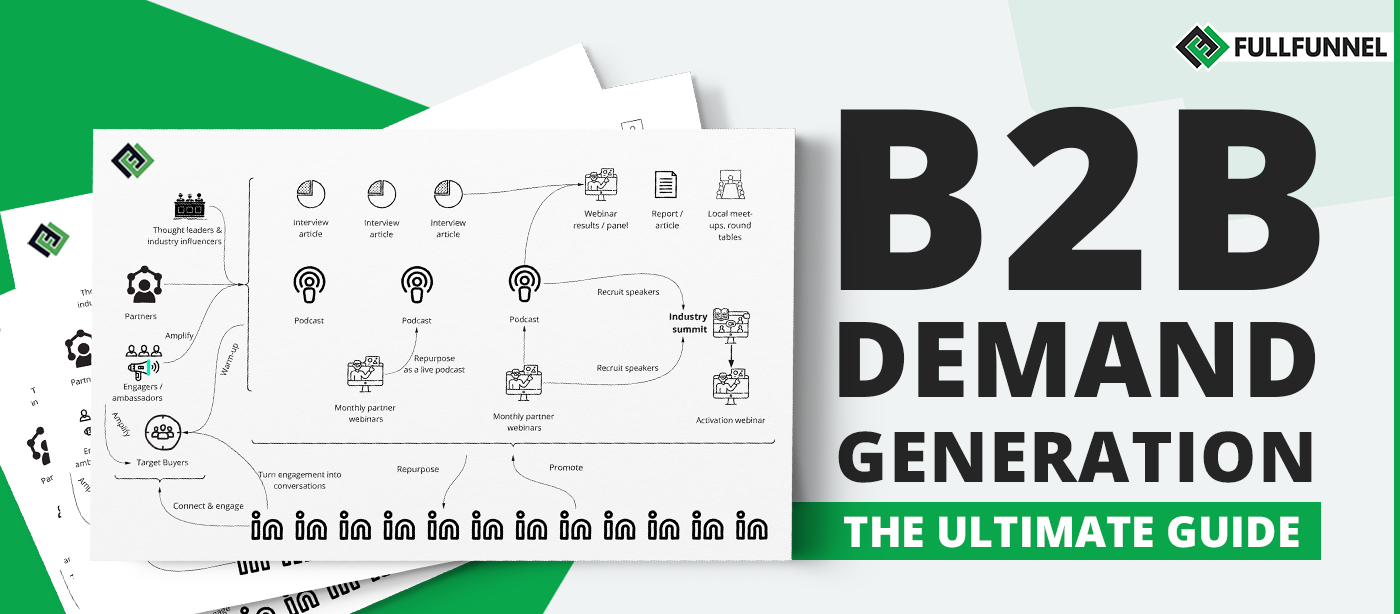Bonus material: Demand generation calendar
B2B demand generation has become a buzzword everybody talks about, but you rarely see practical examples or case studies.
For many B2B marketers, demand generation is all about running ads to ungated content with occasional thought leadership, podcasting, and blogging. These activities should be added to your demand gen mix, but they are not the complete demand strategy.
In this guide, I’m going to share with you:
- A framework we used to generate 72 inbound opportunities and >$1 mln inbound pipeline for Fullfunnel.io with just 2 FTEs in the 1st year of business
- Modern demand generation campaigns that drive results
- Demand generation waterfall to create awareness in the target market
- How to introduce and launch demand generation in your company and get support from senior leadership
Let’s dive in.
Table of Contents
ToggleDemand generation vs lead generation vs demand capturing
Before we’ll dive into practical stuff, let’s quickly nail down what demand generation is and how it is different from lead generation and demand capturing.
What is demand generation?
From my perspective, it’s a long-term ongoing activity to create awareness in the target market, and generate demand for your product. The ultimate goals of demand generation are:
- Increasing the volume of inbound opportunities (companies reaching out to you about your product) from your ICP.
- Warming up target accounts to make it easier for sales to connect with them. Sales will talk to accounts that are already aware of your product.
- Shortening the sales cycle and increasing the win rate
What is lead generation?
These are short-term sales-focused tactics that are supposed to generate sales opportunities fast, even from companies that are not actively buying. Lead generation tactics heavily depend on volume and include standard tactics like:
- direct ads,
- gated PDF with further sales outreach,
- webinars where they pitch their product.
This graph perfectly explains lead generation tactics.
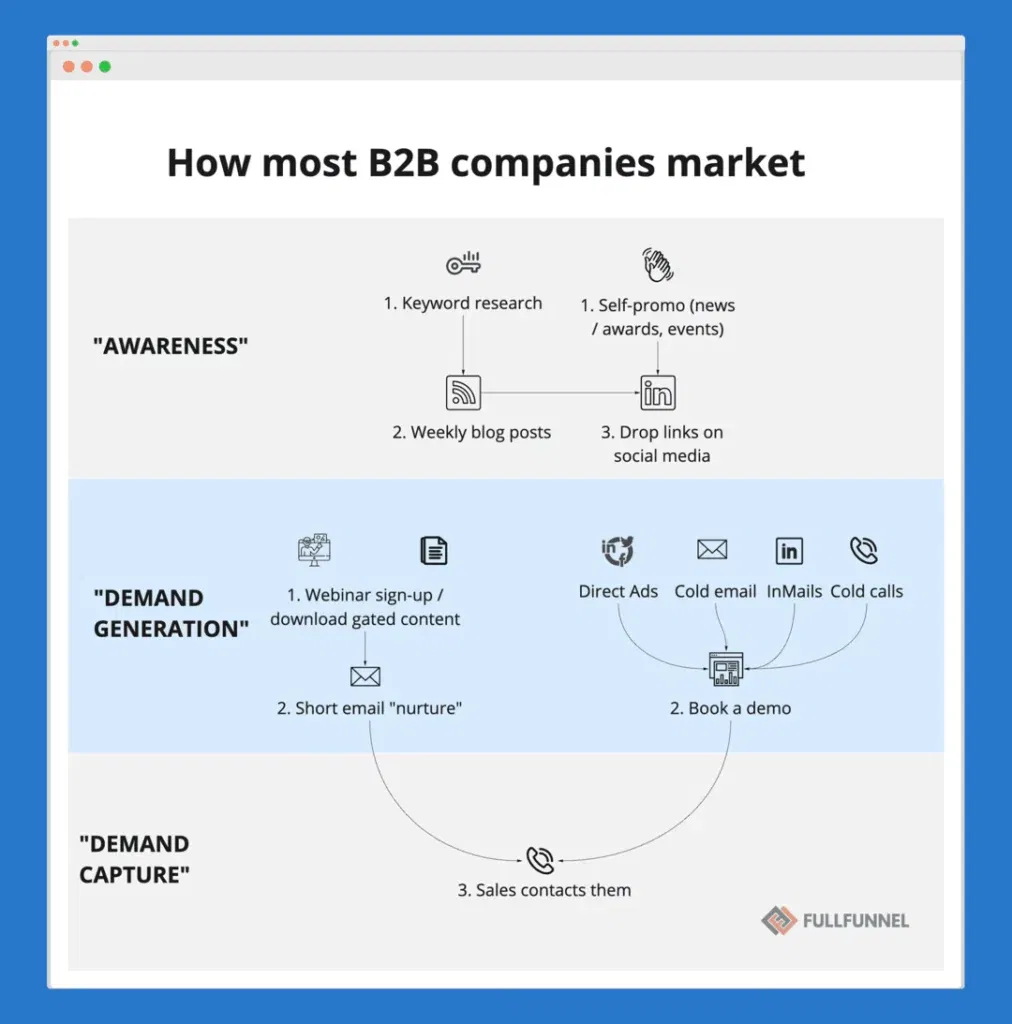
What is demand capturing?
Demand capturing is identifying engaged accounts that fit your ICP (companies that demonstrate a significant interest in your product – we’ll cover it later) and marketing to companies that are actively looking for the solution.
To wrap it up, I want to share a graph created by Gaetano Di Nardi that provides a great comparison of all three functions.
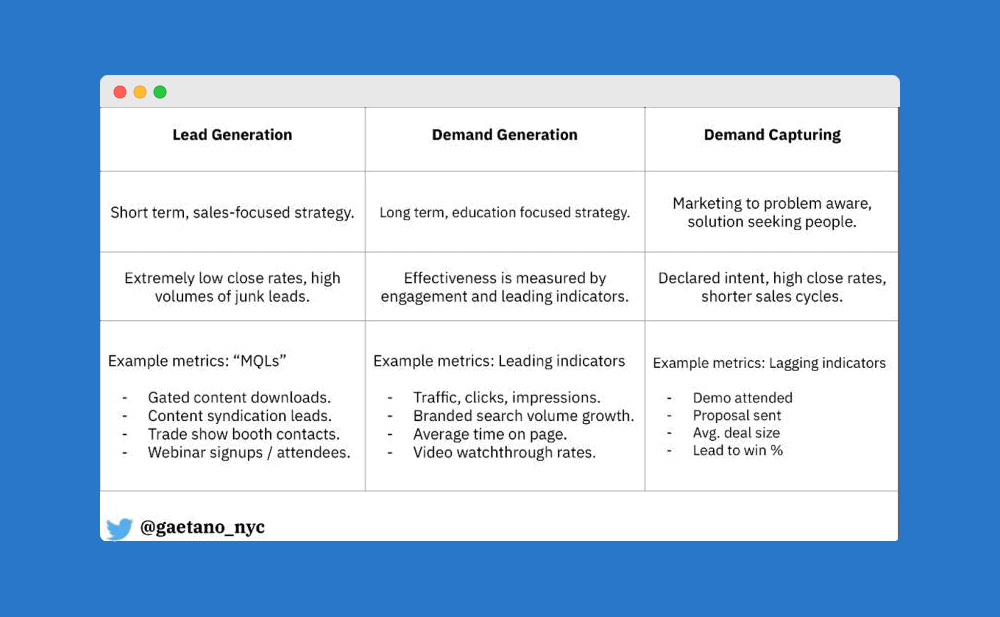
Most B2B companies don’t understand lead generation and treat it as an offensive tactic. They assume that there are tactics that can convert companies that are not actively looking for a solution with a specific tactic, fast.
Hence, they run direct ads, promote gated content, and webinars where they pitch the product.
B2B companies are impatient and want the results NOW.
Lots of them have pressure from the investors or are led by CEOs/CROs that don’t have a marketing background. These people assume that marketing is all about making customers aware that their product exists.
Even if different marketing initiatives make sense to them, these ideas are shut down just because:
- it takes time to launch and get results
- it seems to be non-scalable and non-predictable.
These companies are ready to spend years changing marketers, marketing agencies, and SDRs to get short-term results. But they are not ready to invest the same time in doing the right things that produce long-term wins and growth.
They are product-biased.
They assume they have the best product in the market, and they need just 2 things: a skilled person who can write great copy for ads + sales veterans who can sell anything to anybody.
They live in their delusional world looking for people who excel at «sell me this pen».
This continues until they learn the lesson the hard way and understand that «LEADS» are the consequence of
- brand awareness,
- demand generation,
- WOM & customer advocacy,
- great product.
They become interested in your product not because they saw an ad telling how great your product is or a cold email from SDR.
They become interested when they believe your product is one of the best possible solutions to their challenges.
Lead generation is not a linear function. At least, not in B2B enterprise sales and marketing.
Don’t expect that automated, templated email and Inmail cadences amplified by multichannel ads will grow your pipeline.
It’s a buyer-dominated market, and you must market the way your customers are buying, not applying gimmicks and growth hacks.
If it makes sense, why then do B2B companies still prefer lead generation to demand generation?
Here are 5 reasons.
1. It’s easier and faster to launch.
You can buy ZoomInfo, LinkedIn Sales Navigator, and sales outreach software to launch a cold outbound campaign in a few hours. The same with direct-response ads.
Compare it to marketing activities that should create awareness or generate demand where you need to leverage customer insights and have the right skill set.
2. Scalability.
Lead gen can be scaled faster by adding more budget or hiring more SDRs. Awareness, demand generation, and ABM programs take a lot of time to scale.
3. Direct attribution.
Lead generation campaigns can be easily attributed to revenue in your analytics software, so they seem to be more predictable.
Demand gen campaigns require a mix of self-attribution, customer interviews, and digital tracking which most companies don’t have. As a result, they can’t see an impact on revenue.
4. Linear funnel.
Lead generation function is linear: ad/cold email → Landing page → Demo call → Deal Won/lost.
B2B demand generation is not linear.
5. Lead gen can be easily outsourced.
You can quickly find and hire a lead gen agency or growth hacker that will be working on booking meetings for you without involving your team.
Demand gen can be outsourced only partially and requires close collaboration with your marketing team.
Here is a harsh truth about lead gen.
Most of your buyers are not actively buying, so your ads and outreach will be ignored and generate miserable ROI. You’ll burn out your budget and your market fast.
The lead gen function puts leads, not revenue, as a core metric, so your team will never focus on demand generation and market to the cold audience. As the result, your product will always be compared to others and your company will be perceived as “yet another vendor”.
Lead gen scales faster, but in the long term, the lead gen performance significantly decreases.

Drawbacks caused by lead gen:
- Non-differentiated positioning and marketing message
- Lack of account research and personalization
- High CAC
Compare it to demand generation and ABM programs that scale slower but in the long term significantly over-perform lead gen by:
- Shorter sales cycle
- Higher ACV
- Higher lead to conversion/win rate
Let’s discuss the B2B demand generation function and how to launch it.
Demand generation waterfall

I look at B2B demand generation as a demand waterfall that has 3 pillars:
- Awareness and demand generation activities.
- Content distribution
- Demand capturing
1. Awareness and demand generation activities.
To develop an efficient demand generation strategy, you need to understand the buyer journey first: how your customers are searching, learning, and buying.
The next step is defining demand activities that can create awareness and demand and align them with the buyer journey. These activities can include:
- Create demand and awareness via proactive thought leadership.
- Launch a 1:few partnership webinars and market research with niche associations or communities
- Create personalized content hubs for buyer’s enablement and further nurturing
- Content co-creation with target accounts
- Interview target accounts on your podcast
- Target accounts with top-performing content to boost awareness
- Retarget accounts with detailed case studies/use cases to identify engaged accounts for nurturing and demand capturing
- Well-researched guest posts on the blogs/newsletters/communities your target accounts are following
- Blog posts focused on solving specific challenges/answering questions your buyers have instead of generic writing for a high-volume keyword
- Proactive content distribution
- Niche-focused events to boost awareness and establish a relationship
- Collaboration with thought leaders
- A newsletter that covers a specific topic in-depth instead of pitches and corporate press releases
I usually categorize and put them into 4 pillars.

4 pillars to create awareness and demand
1. Content collaboration.
Content collaboration with 5 audiences, including launching a podcast, blog articles, partnership webinars, and guest posts:
- Target accounts
- Thought leaders
- Engagers (platform active members)
- Communities & associations
- Industry media
2. Events.
- Micro-events with thought leaders for a specific group of target accounts
- Summits
- 1:few and 1:many educational webinars
3. Social engagement.
- Engage with the 5 audiences I mentioned above. Quite often, engagers and thought leaders might return a favor and feature you in their podcast, newsletter, or blog.
- Start a thought leadership program. Repurpose best-performing content to target accounts and boost brand awareness.
- Engage with niche communities and associations. Answer questions, run AMAs, and collaborate.
4. Paid promotion.
- Boosting your top-performing content to target accounts
Why these 4 pillars?
Here is the truth.
In most markets, there is no demand for your product or your product category. People simply don’t understand they have a problem your product solves. Lots of education is required.
Now, if they are not looking for a solution, how are you going to market to them or, at least, attract their attention?
B2B buyers don’t log in to social or the community because they want to see a new product ad. They do it to see updates from their peers, learn from the thought leaders and engage with the community.
They come for content and entertainment.
You can create awareness and demand only when you’ll be consistently connecting and engaging with your target audience, and talking in different formats about:
- the challenges your target buyers have,
- solutions & ideas they can apply,
- practical advice and market insights
2. Content distribution.
Whenever I discuss demand generation programs with B2B marketers, I often hear back that they don’t have a clear content distribution plan. They just sporadically share published content on social and promote it via ads.
Here is the truth.
Unless you are a well-known brand that constantly produces top-notch content your audience is eagerly waiting for, you need to have a proactive distribution plan.
Here are 5 ways to get your content noticed by your target audience.
5 content distribution tactics.
1. Grow your audience you can connect with directly.
Assets like email newsletters, WhatsApp/Telegram channels, or your own community enable you to directly communicate with the target audience. You become independent of social algorithms, Google updates, or traffic costs.
These assets simplify the process of accumulating your audience and have a low entry barrier.
2. Borrow audience.
Find non-competitive companies that also sell to your audience and run co-marketing campaigns with them:
- Educational webinars
- Mentions and link exchange
- Featuring each other on the podcast, etc.
- Publish guest posts on industry-known media
Whenever you run these activities, mention your assets to “borrow audience”.
3. Leverage social & communities.
Engage with the target audience in the channels they use for research and education, including:
- Industry communities and associations (like Trenches – a free community for B2B marketers)
- Social media
- Old-fashioned forums that are still popular in many conservative markets
4. Involve sales in content distribution.
If this sounds controversial, think about these facts for a second:
- 90% of B2B decision makers never respond to cold outreach (HBR).
- 62% of B2B customers respond to salespeople who connect by sharing content and insights that are relevant to the buyer (LinkedIn).
- 81% of buyers are more likely to engage with brands that have a strong, cohesive professional social media presence (LinkedIn).
- 92% of B2B customers are willing to engage with sales reps who have positioned themselves as an industry thought leaders. This credibility is often attained by posting regularly on social media (LinkedIn).
First, sales reps are already connected with your target accounts. Every piece of content is a fantastic non-sales touch to open or reengage the conversation.
* Non-sales touch means a message or email without pitching or following up with prospects. Consider it an email to your friends. You ask about how it’s going and share relevant content that might be helpful or valuable for them.
Second, by sharing the content sales position themselves as trusted advisors, not SDRs nobody wants to talk to.
One caveat:
The content that you produce should be in-depth and comprehensive. No salesperson will share content that will make them look amateur.
- Paid promotion.
I mention paid promotion as the last tactic because of the fact I mentioned in the beginning:
If your company is an unknown brand, and you rely on paid promotion only, you’ll burn out the marketing budget fast.
Paid promotion amplifies the 4 tactics I mentioned above but doesn’t replace them. Here are some ideas on how you can use it.
- Promote your best-performing organic to target accounts that engaged either with your content, visited your website, or signed up for the recent event.
- Use short clips from podcast episodes with the thought leaders and show them to their followers that fit our ICP. Later, retarget them with the content from step 1.
- Retarget accounts that visited your product page with case studies and short customer testimonials.
- Collect engagement insights, manually connect and engage with accounts that hit your engagement threshold.
Watch below the webinar where we explain with Justin Row how to set up a perfect content promotion and demand capturing ads strategy on LinkedIn.
There are many conversations comparing demand generation to demand capturing, but the truth is that you need both.
You can’t expect your car to ride if the wheel, tire, or anything else is missing.
The same with B2B marketing.
Create awareness -> Grab attention -> Generate demand -> Capture the demand → Onboard and expand – this is a B2B marketing 101.
3. Demand capturing.

Let’s leave theory aside and focus on demand capturing tactics.
Traditionally, demand capturing in B2B marketing means
- Running direct ads related to your product (e.g. Ad promoting email marketing software to people who search on Google for this keyword).
- Optimizing landing pages for the same keyword.
- Running a retargeting campaign promoting a demo or free trial to people who visited the website.
While these tactics are wildly used for low ACV B2B products with a short sales cycle, they generate miserable returns for complex high ACV products with long sales.
The main difference is that in complex B2B, we capture the demand at the stage where buyers show engagement and significant interest in your product, but didn’t make a decision if they want to go with your product.
They might be doing research, evaluating vendors, checking your use cases, or trying to figure out if your product is the right fit for your needs.
So instead of trying to push them to book a demo, we leverage these insights to connect with the engaged accounts and learn more about their needs.
Here are 2 ways we capture the demand in complex B2B.
2 ways to capture the demand in complex B2B.
1. Set up an engagement threshold and track account engagement across multiple channels and your website to identify accounts that demonstrate high interest in your product.
Example of engagement threshold:
- Spent 30 minutes on your website reading a case study
- Checked the pricing page
- Signed up for a product webinar
- 3 visits in the last 30 days
You can proceed with warming up and activating the engaged accounts with account-based marketing tactics and retargeting promoting dedicated case studies or customer stories.
Here is a video where we explain in detail the process of tracking account engagement.
2. Buyer enablement program: solution-based content hubs to capture the demand from the warm prospects (e.g. ABM content hub).
Content hubs provide 2 fantastic benefits.
1. Buyer enablement.
Keep in mind that quite often sales won’t be talking to the decision-makers, but to the Champions.
These people will be selling your solution internally and will get lots of questions like
- Budget justification and ROI
- Vertical use cases and results they can expect
- Migration, security, and onboarding
- Risks coming from selecting you as a vendor
You can put inside the content to address all of these points.
2. Intent insights.
You’ll see who and how often engaged with your content, and what exactly they consumed. It gives priceless insights for precise and timely follow-up.

Follow the process, and your sales team will never complain about the pipeline and marketing-sourced revenue.
In the next section, I’ll share a short overview of our company’s demand generation strategy. You’ll see a demand waterfall model in action.
Overview of Fullfunnel.io’s demand generation strategy
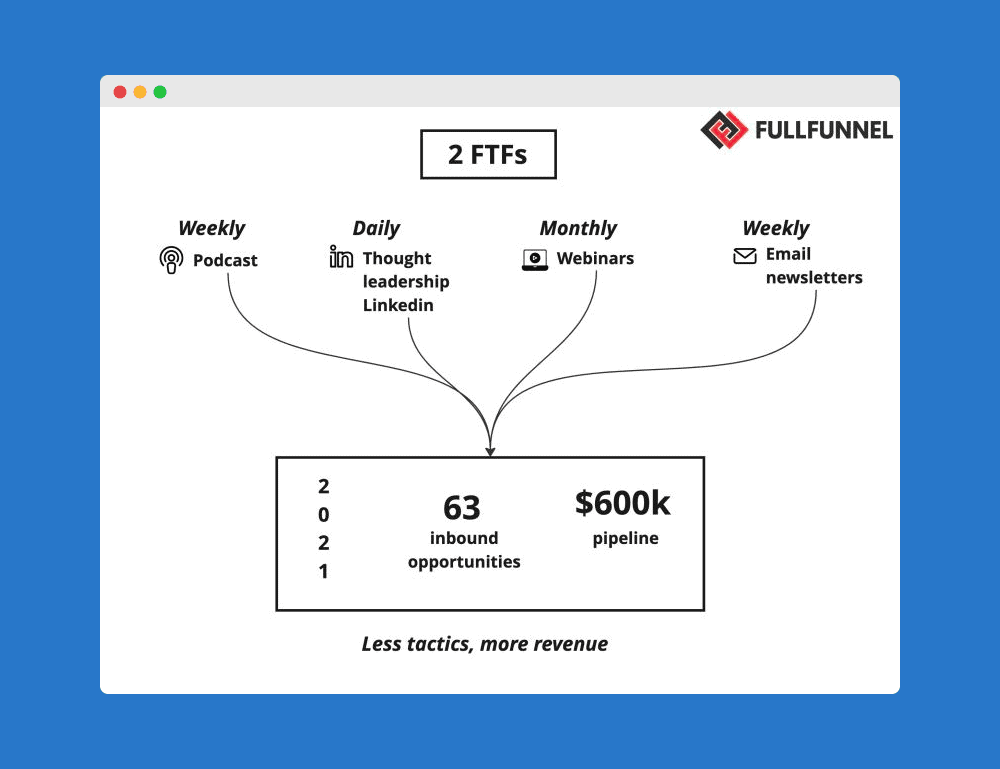
I know that aside from theory, you want to see a practical example of the demand generation strategy. Let me share a simple demand gen strategy we used with Vladimir when we launched Fullfunnel.io at the end of 2020.
In 2021 (the first year of business) we generated 63 inbound opportunities and a $600k pipeline with 2 FTEs.
9 pillars of Fullfunnel.io’s demand generation strategy.
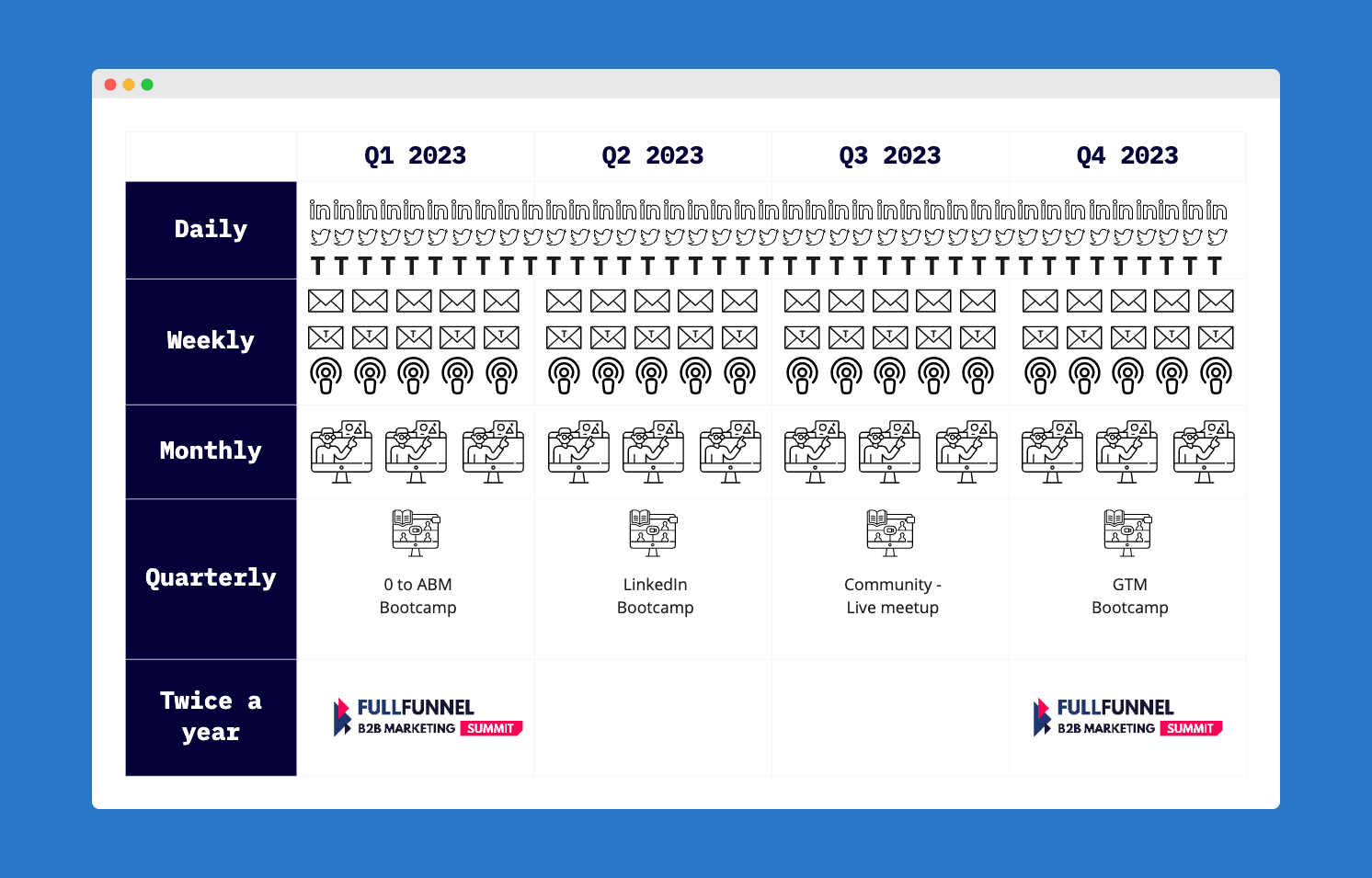
1. LinkedIn thought leadership and proactive engagement.
Every workday, our senior marketing team (Andrei, Vladimir, and Stapho) posts actionable content about account-based demand generation and proactively engages with 4 audiences:
- Engagers
- ICP
- Event organizers
- Partners
As a result, 91% of our inbound requests mention LinkedIn as the channel where they first heard about us.
Every month we host an educational webinar with tech companies that serve similar audiences – B2B tech companies with high ACV.
We don’t pitch, both promote with a partner the event, expand the network and generate awareness and demand.
In 2021, we hosted 9 webinars with Chili Piper, Nick Bennett, lemlist, Happierleads, Scott D. Clary, MBA, and that generated:
- 4 clients
- 15 sales opportunities
- 2723 sign-ups
3. Monthly case studies.
Every month we promote an actionable case study with the details of the campaign we launched with one of our clients. These case studies usually create the most demand.
4. Weekly Full-Funnel Insider newsletter.
Every Friday, 2 pm CET – 8 am ET we send a new email newsletter. We cover breakdowns of our campaigns, ABM and demand generation frameworks, case studies, curated best LinkedIn updates, and recordings of our podcasts and webinars.
5. Weekly Full-Funnel B2B Marketing Podcast.
Every week we sit down with prominent B2B marketing leaders to discuss all things related to B2B marketing. Everybody from our community can join and ask questions live.
6. Annual Full-Funnel B2B Marketing Summit.
In 2021, we invited 50+ speakers and hosted a 5-day virtual summit that was attended by 4k+ people across the world. In 2022, the summit was attended by 5.5 people.
7. Content distribution.
When a new article goes live, or when we update the existing content, our team distributes it across our assets and social channels. As well, we use this content as a non-sales touch, sharing it with target prospects or getting feedback from clients.
Here is a simple content distribution plan we use.
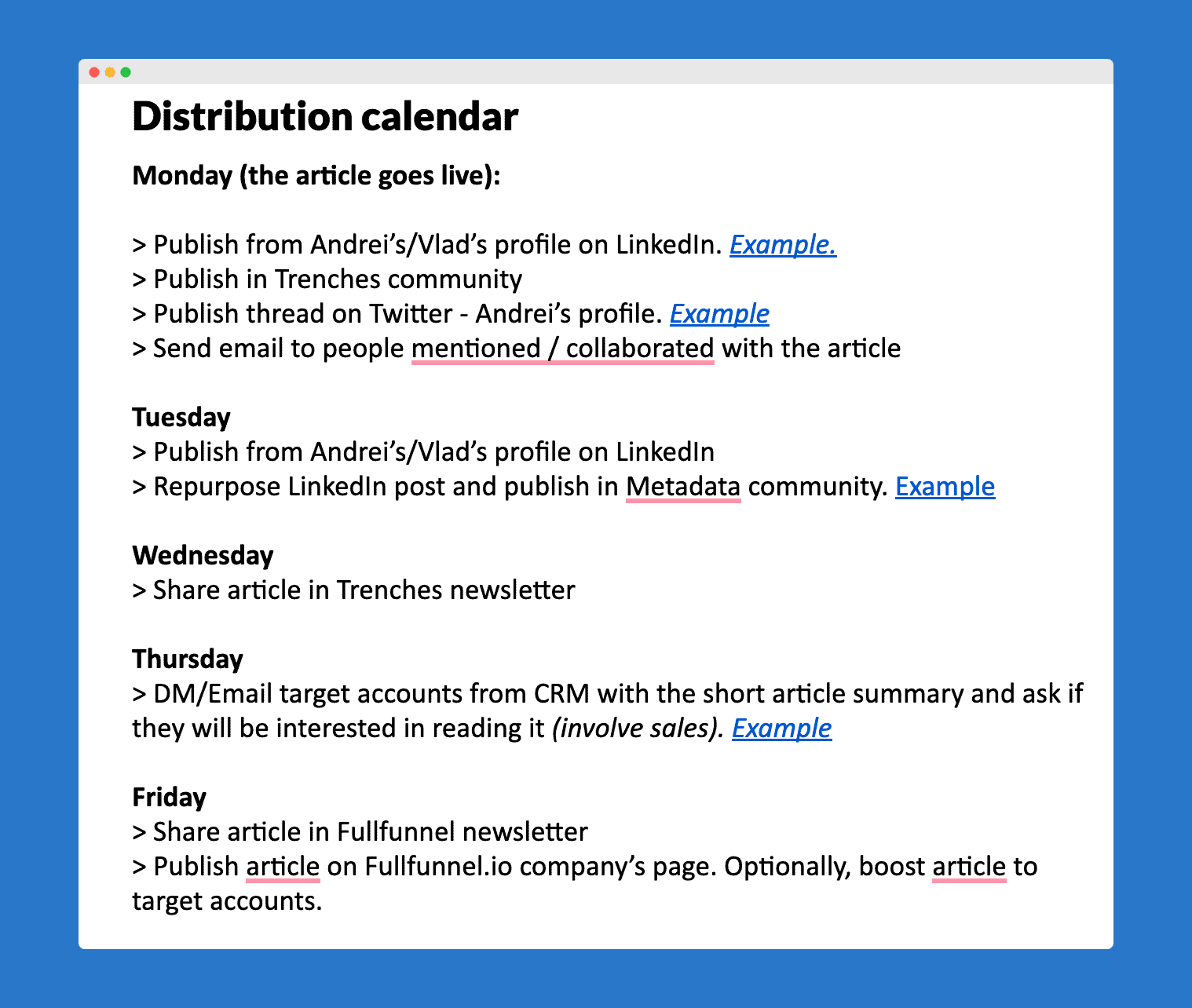
*Download our demand generation calendar and content distribution plan here.
8. Guest posts and podcast appearances.
We have published several articles on well-known resources:
- CXL: Common B2B Challenges and How To Solve Them
- MarketingProfs: Sales Outreach in Five Steps: How to Run Campaigns That Get Results and Don’t Burn Your Leads
- Terminus: 3 ABM Campaigns to Grow Your Pipeline in 2022
- Sales Hacker: The Ultimate Guide to Developing Your B2B Marketing Strategy Framework
Guest posts not only create awareness in the target market but provide great social proof for our brand.
9. Demand capturing with content hubs and website engagement.
I’ve already described the approach in the previous section.
Now, the only question you might have is how to launch a B2B demand generation program from scratch.
Let’s dive in.
How to launch a B2B demand generation program
Here are 10 steps to launch a B2B demand generation program.

1. Develop a demand generation strategy.
Demand gen is not a bunch of organic and paid tactics. Make sure you have:
- Clear ICP
- Marketing message: positioning and value proposition
- Clear goals and leading indicators to track them
- Resources to run the program
2. Customer research.
Run customer interviews and analyze the digital behavior of your buyers to understand:
- What channels do your buyers use for education and research?
- What are the questions and topics they are interested in?
- What are their KPIs, “jobs to be done” and the typical challenges?
- Who do they follow and trust?
- What communities/associations do they engage with?
Tune in to the podcast episode I had with Zineb Layachi where we describe the step-by-step process of running customer interviews.
3. Categorize topics.
Categorize demand topics and put them into 4 buckets.
- Business triggers that push your buyers to start looking for solutions like yours.
- Demand triggers: what can attract their interest and motivate them to learn more about the problem or an opportunity?
- Discovering and evaluating.
- Decision-making: what can influence their decision?

Many B2B companies think about content marketing as a game of numbers:
more articles -> more keywords + longtails -> more traffic -> more revenue.
I wish B2B marketing was similar to eCommerce ?
The quality of content outweighs the quantity.
Focusing on providing comprehensive answers to your buyers’ challenges generates more opportunities than generic top-of-the-funnel articles for the high-traffic keyword.
B2B companies miss one point:
The goal of the content is not to generate traffic but to generate demand and inbound opportunities.
Here is how to shift from traffic-oriented to demand-oriented content.
1. Understand the business triggers that can push your buyers to search for solutions.
Why do they even start the journey? What’s happening in their business to trigger their search?
Fullfunnel.io example:
Why does our ABM program underperform and CPA is extremely high?
2. Understand demand triggers.
What can attract their interest and motivate them to learn more about the problem or an opportunity?
Example: What is ABM? How to create ICP? How to develop positioning? How to create a sales funnel? How to generate enterprise clients?
3. Discovering and evaluating solutions.
How do they explore different solutions? What can motivate them to learn more about our solution?
Our example: How to launch an ABM efficiently from scratch?
4. Decision-making.
Why would they select us? What can influence their decision?
Key takeaways.
You don’t need more random, uncontrolled traffic.
You need visits from target accounts that want to consume your content and might be potentially interested in your product.
Less traffic, more demand.
Fewer leads, more revenue.
This should be the right demand generation motto.
4. Prioritize demand generation campaigns.
Map out all demand generation campaigns you believe make sense to launch.
Prioritize them by
- scope
- budget
- resources
- easiness of launching
- potential impact.
5. Develop or refine demand capturing.
Before launching a pilot demand gen campaign:
- Reduce friction points (long forms, pricing unavailable, etc.)
- Define one process of demand capturing (retargeting of engaged accounts, intent data, content hubs)
6. Select and launch pilot campaigns.
Don’t push all of your resources into the pilot campaign. Instead:
- Define the goals and align them with sales and execs.
- Define a small pilot team (2 people max). Reduce KPIs/reallocate revenue targets.
- Select only one channel and one program. Don’t do multiple things in parallel.
- Create a clear timeline and leading metrics to track progress.
7. Operationalize pilot campaigns.
After your campaign gets traction, document the process and onboard or hire a team member to maintain the campaign.
8. Create a demand generation report.
Add a mix of self- and digital attribution (digital analytics + How did you hear about our product?) to show the impact of marketing on revenue.
9. Grow demand generation function gradually.
Gradually launch and document new demand generation and demand capturing campaigns.
10. Build a demand generation team.
Don’t hire for the process that doesn’t exist in the beginning. Bring people to maintain the existing campaigns, refine them and give some space for experimentation.
One caveat:
Don’t get too excited about launching 20+ campaigns.
In reality, 4–6 campaigns and 2–3 channels where you excel will be more than enough to grow your brand presence, generate demand, and marketing-sourced revenue.
Here is a webinar about going from 0 to demand generation where we explain each of the steps in detail.
How to shift from lead generation to demand generation?
One key requisite to shift from lead generation to demand generation is change management.

Change management includes alignment between senior leadership, marketing, and sales on 6 important points.
1. Accept existing challenges.
- Your product is unknown and nobody wants to buy it
- Prospects don’t understand product value
- Sales don’t understand the buyer’s journey and needs
- You have a low win rate because of leads that are not ready to buy
Both senior leadership, sales, and marketing should accept them and create programs to solve the challenges.
2. Set up realistic goals.
Just because your company raised doesn’t mean you can set up unrealistic goals.
Having more budget ≠ generates more revenue if the challenges from the previous step were not solved and your company doesn’t have proven marketing frameworks.
3. Demand generation campaigns shouldn’t be measured by leads only.
You’ll have a set of campaigns with the primary goal of creating awareness and educating target buyers.
Hence, demand generation campaigns should have their own set of leading metrics that are aligned with a consolidated revenue report.
4. Demand generation operations instead of one-off campaigns.
As you have seen in the overview of Fullfunnel.io’s demand generation strategy, the demand generation calendar and regular operations are crucial for success. It’s a long-term strategy, not a one-time activity to generate revenue fast.
5. Time, commitment, and patience are the keys to success.
Too many B2B companies give up too early just because they didn’t generate sales opportunities immediately. They feel that demand generation is a burden and return to a convenient lead gen they had been doing for years.
Demand generation won’t generate revenue results fast, but it has a long-term compounding effect:
- building a company’s brand,
- emphasizing positioning,
- and creating awareness in your target market.
One of the best proofs of it is you can find it in the book called “The Psychology of Money” written by Morgan Housel.
Housel shared an interesting fact about Warren Buffett. Buffett accumulated an $84.2 billion net worth after his 50th birthday. $81.5 billion came after he qualified for Social Security in his mid-60s.
One important takeaway Housel makes:
Aside from the investing acumen, the real key to Buffet’s success is that he’s been a fantastic investor for three-quarters of the century!
That’s the best example of time, consistency, and compounding interest in action.
How and why has Cognism shifted from lead generation to demand generation?
One of the best examples I witnessed in the B2B MarTech space is Cognism’s switch from lead generation to demand generation.
I chatted with Fran Langham, Global Head of Demand Generation at Cognism, about their journey.
You can listen to the full episode and read key learnings below.
What triggered Cognism’s shift from lead gen to demand gen?
It all started when some members of Cognism’s lead gen team started listening to Chris Walker’s podcast. They looked at the results they were getting from their lead gen model and realized that they generate tons of leads that were not converting into revenue.
Cognism split the funnel and found they needed 25 direct inbound demo requests to secure one deal. To win one deal, their team needed 500 leads from ebooks or webinars.
Here is a typical lead gen setup they used to generate these leads.
- Content team writes an ebook.
- Marketing creates a landing page and gates ebook.
- Performance team promotes ebooks on social via ads
- Marketing collects downloads, moves them to CRM, and transfers them to sales.
- Sales call the leads and follow up.
While they generated many downloads, they generated very few sales opportunities because there was no intent to buy.
The main bottleneck during the shift Cognism faced.
Here is what Fran says.
The biggest issue for the marketing team was getting the buy-in from sales. There was a lack of patience. Because when you initially switch to a demand gen approach, you don’t suddenly get loads of inbounds overnight. It does take time.
While making the switch, there will be a decrease in leads. But what matters is quality, not quantity.
That can be a little bit difficult, and that’s why you need to educate your teams internally early on. As you can see, change management is inevitable if you want to generate results from a demand generation strategy.
What makes a B2B demand generation program successful?
To finish this massive guide, I want to summarize what makes B2B demand generation successful and the most common mistake.
Here are ten factors that make a successful demand generation program.
1. Have a long-term mindset and support from executives.
We have already discussed this multiple times in this guide.
2. Alignment between marketing and sales.
Your team should work on the same account list and have alignment on ICP, goals, and metrics.
Align content and distribution channels with the customer journey and informational needs of ICP. Promotional tactics are secondary.
3. Project owner.
If nobody is in charge of the project, your demand generation initiative will fail. There will always be people who deprioritize demand generation, won’t like to step out of their comfort zone, and follow the weekly pillars. You need somebody to control it.
4. Consistency.
You can’t expect your muscles to grow by attending the gym once a month.
You can’t expect results from demand generation if you don’t run it consistently. A demand generation calendar with daily, weekly, monthly, and quarterly activities is crucial.
5. Launch small-scoped new activities.
First, small-scoped campaigns are easier to launch.
Second, you won’t lose the trust of senior leadership or sales if you’ll make mistakes. When you establish a robust process, you can scale it.
6. Content creators and in-house experts.
Define subject-matter experts. Set up regular interview calls with them. Transcribe and turn their insights into actionable content.
7. Diversified content strategy.
Diversify your content strategy and align it with the needs and interests of different buying committee members.
If you read our blog or follow us on LinkedIn, you can see that our content fits the needs of different roles:
- CEOs,
- VPs of marketing,
- ABM or field marketers,
- demand generation marketers.
8. Demand capturing and activation playbooks.
Develop playbooks that will help convert engagement into sales opportunities.
9. Right metrics to track.
Followers and likes are not the leading indicators but vanity metrics.
What matters is
- # of conversations & opportunities with strategic accounts
- Account engagement
- Inbound requests
10. Great content is only 20% of success. 80% of success comes from content distribution.
If your target audience doesn’t consume your content, you waste time.
Demand generation mistakes
The last part of the guide I want to dedicate to 7 B2B demand generation mistakes I often see.
1. Lack of customer insights in the content strategy.
Want to generate demand with your content?
Leverage a simple formula:
In-depth answers to your buyers’ most important questions + your expertise/examples = demand.
2. Copying B2C/E-commerce approach.
More articles -> more keywords + longtails -> more traffic -> more revenue works in B2C but not in B2B.
Your buyers don’t need MORE content.
They need better, comprehensive content that answers specific questions they have during the buying process.
3. Hiring cheap writers.
Most B2B companies:
- hire cheap SEO content writers that find keywords with high traffic volume,
- analyze the ten most popular articles,
- rewrite the summary of these articles adding your product features.
B2B buyers smell low-quality content miles away and ignore it.
And no salesperson will ever help you to distribute it if they feel this content presents them as amateurs.
4. Blindly copying marketing leaders.
Many B2B companies copy market leaders in their industry because “if they do this, it should be the right approach.”
Keep in mind that you don’t know their goals and GTM strategy. You don’t have their skillset and their budget.
Market leaders can afford experiments & losses, but can your company afford it?
5. Replacing demand generation with linear content funnels.
Demand generation is not linear.
If a person downloads an ebook or signs up for your webinar, it means they are interested in the topic, not your product.
If you send these contacts to sales, you’ll burn out your pipeline fast.
6. Press releases wrapped up in demand generation.
Here is a harsh truth.
Nobody cares about:
- trade shows or conferences you’ve attended
- the money you raised (aside from SDRs who’ll use it as a trigger to spam you ?)
- pictures from your corporate events, or awards you won.
It provides 0 value to your buyers and doesn’t generate demand for your product.
7. Attribution and lead generation obsession.
The primary goal of the content is helping buyers, educating them, and making them interested in your product, not selling.
But because B2B companies can’t attribute these programs, they turn demand gen into lead gen.
Webinars become sales pitches.
Blog articles promote product features instead of answering the most challenging questions your buyers have.
Define leading indicators and get everybody aligned.
The most common question I get is how to measure brand awareness and efficiency of demand generation and thought leadership.
Here are the metrics I’m looking at:
- # of media invites and quality of invites (podcast interviews, quotes, public speaking, etc.)
- # of brand mentions as a product/vendor recommendation
- Direct brand traffic
- # of inbound opportunities
- Sources of opportunities (How did the prospect hear about us?)
Fix these 7 bottlenecks, and you’ll start noticing increased revenue, shortened sales cycle, and higher ACV.
Takeaways and next steps
The buyer journey is not linear. If you try only to capture the demand or prospect accounts that are actively buying, you are already late.
Understand how and why your customers are buying.
Define the key activities to create awareness, attract attention, and generate demand aligned with the buyer journey.
Develop a demand generation function with a long-term mindset.
If you need help with developing a B2B demand generation function, book a call here or dm me on LinkedIn. You can learn more about our services here.
If you want to uplift your skills and learn more about the complete Demand Generation Strategy, get step-by-step guidelines to launch a program in 90 days to generate account engagement and marketing-sourced pipeline check out our B2B Demand Generation Playbook.
Inside you’ll find:
- Five behind-the-scenes demand generation playbooks
- 25 short and actionable videos and tutorials (no theory or high-level overview, just 15-mins max videos to explain a specific process or show how to implement it)
- 10 ready-to-use templates, Including demand gen reports, budgeting, creating playbooks, a pilot demand generation program presentation, demand generation program examples, thought leadership, nurturing content production templates, and many more
- 30/60/90 launch plan: get step-by-step instructions, a plan, and a timeline

